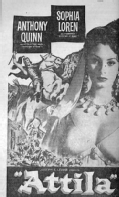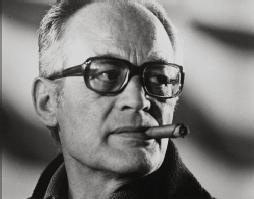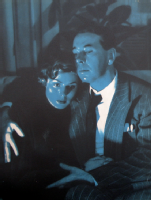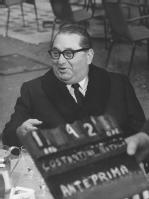Open Workshop: Producers and Production in Italian Cinema
Wednesday 15 June 2016
This workshop is the first event of the AHRC major research project: 'Producers and Production Practices in the History of Italian Cinema, 1949-75'. For general information on the project, click here.




Programme
10.00 – 10.15 Stephen Gundle (Warwick): 'Welcome and presentation of the project'
10.15 – 10.45 Andrew Spicer (UWE): 'Production studies - contributions and prospects'
This overview will explore the emergence of production studies (or ‘media industry studies’) as a sub-field – why and in what ways it has sort to distinguish itself from other approaches to the study of film (and media generally). It will review some of the major contributions and the nature of the debates. The presentation will end by adumbrating some of the ways in which production studies could develop and how this AHRC project might contribute to that broader agenda.
11.00 – 11.30 Barbara Corsi (Warwick): 'Italian producer studies - the state of the field and the Cristaldi archive'
The study of the economic aspects of Italian cinema has been widely neglected. producers and their practices have been victims of this relative neglect. Only a few studies existed prior to a 1986 conference on the Italian film industry which gave rise to volumes on Titanus and Lux. Since then more work has been done, including chapters in Brunetta's Storia del cinema mondiale and the multi-volume Storia del cinema italiano. Monographs have appeared on production companies, including Cines, Galatea and Titanus (again) those these are not always adequate. The need for archival work and the value of this is very apparent. Several institutions have begun to move in this direction generating such projects as Catholics and Cinema in Italy Between the 1940s and 1970s and Progetto Pittaluga. Further archival work promises to reveal much about the operations of figures including Salvo D'Angelo and Franco Cristaldi. The final part of the paper will outline the contents of the Cristaldi archive and highlight documents of particular interest.
11.30 – 12.00 Pauline Small (QMUL): 'Anglo-Italian co-productions'
This paper draw on the detail of my forthcoming publication ‘Anglo-Italian Co-productions in the 1950s and 1960s: Film Finances, the Prince, and Venice’ available online here. I will give attention to the archival sources accessed in this and earlier publications; and indicate also other material I have uncovered which may be relevant to establishing production trends. Though inevitably brief, I plan in addition to raise more general questions regarding the use of archives: their potential - and limitations - in enhancing our understanding of the cultural, political, and economic factors at play in the industry in the 1950s and 1960s.
12.00 – 12:30 Marie-France Courriol (Cambridge/Lille): 'Franco-Italian co-productions'
Under which circumstances can a film be seen as originating from or belonging to a specific area? To investigate this question, it can be useful to go back to the golden age of Franco-Italian co-productions from 1955 to 1975, which formed the template for later joint ventures. This exemplary period witnessed a common construction of cinema, not only in terms of shared imaginaries but also with regards to financial agreements and common policies. How did these co-productions come about and how did they challenge and formulate the notions of national cinema? Answering these questions is also critical for our understanding of the current debates concerning co-productions, which are a key feature of contemporary European cinema. Italy and France were the first European countries to sign a co-production agreement after WW2. This enterprise was to prove so fruitful that by 1966 Franco-Italian co-productions had reached the record level of 62% of the total Italian film production. What started out as an economic project intended to boost production, share resources and counter Hollywood’s post-war expansion, soon took on an artistic nature. It inaugurated a constant movement of technical and artistic personnel. Successful films, some of which developed into sequels (Don Camillo), led critics to comment upon the existence of strong cultural affinities between the two countries. These interactions can help test the co-productions as a model for transnational creativity. This talk will focus in particular on one of the biggest film scandals of the 20th century: La grande abbuffata (1973) by Marco Ferreri, a Franco-Italian co-production (Mara Films, Paris; Films 66, Paris; Capitolina Produzioni Cinematografiche, Rome). The film starred actors who regularly worked across borders: Marcello Mastroianni, Philippe Noiret, Michel Piccoli and Ugo Tognazzi, and was directed by Marco Ferreri, who then worked and lived between Italy and France. However, La grande abbuffata triggered a heated debate about film nationality and the legitimacy of state funding. As such, it shows that even in the context of the most solid co-production partnership, the popular and critical perceptions of a film’s identity can be volatile and conflicting. This talk will highlight some key issues in the history of Franco-Italian co-productions through an examination of specific cases, and will aim to indicate some potential lines of enquiries.
12.30 – 13.00 Karl Schoonover (Warwick): ‘By Italians, For Italians: Distribution & Exhibition in Italo-American Movie Theatres'
I am researching the distribution and exhibition of Italian films to movie theatres specifically geared towards Italian-speaking audiences in the US during the 1940s and 1950s. Many Italian films came to the US in this period (in fact Life magazine called it the 'Italian invasion' in 1952) and they were distributed with the primary aim of being shown in arthouse cinemas. At the same time, however, these films and other Italian productions were shown in Italian neighborhoods for Italian speakers in special cinemas catering to Italian immigrants. For the workshop, I will share a selection of documents from my initial work in various US archives. Most of these documents come from theatres around New York City (though eventually my focus will extend to look at similar theatres in Chicago, New Orleans, Providence, and Philadelphia). The documents reveal a mixing of languages and audience address, and they cast light on questions of subtitling and cultural specificity. In a moment of tremendous upheaval and uncertainty for Italian-American communities (dealing with the impact of the second red scare newspapers and community organisations based in leftist perspectives while still reeling from the wartime shame and possibility of internment as 'enemy aliens'), these theatres (and the publications they produced) attempted to negotiate a transregional Italianness, forward an agenda of cultural heritage, and foster language preservation and education. The specific address formed by these theatres and their utilization of film in service of such goals appears to respond to the pressures and assaults upon the lives of working class Italians in this period.
13.45 – 14.15 Chris Wagstaff (Warwick): 'The economics of the Italian film industry'
This presentation will consider the market and economic constraints within which producers in the period under investigation (1949 – 1975) had to work; the problems they faced; the solutions to those problems that were available to them; the solutions that they actually chose; and the changing context brought about by evolution in, particularly, American strategies. There will be many statistics. The presentation will be based on previous work and will be addressed to a mixed public, including some experts as well as people who could actually use a sort of basic refresher course in the economics of Italian cinema.
14.15 –14.45 Stefano Baschiera (QUB): 'Small production companies and the quest for an Italian New Wave cinema'
My presentation wants to draw the attention to the role played by small production companies in the 1960s attempts to renew the Italian landscape of art cinema. By looking at the initiatives which led to the setting-up of short-lived production companies with small capitals in order to finance a “young” low-budget art cinema, I argue that in the Italian context the still controversial label of “new wave cinema” can be better defined from an industrial perspective. Companies such as Arco Film, IDI, Cervi, 22 Dicembre, Iride, GA.VA etc. offered a vibrant and heterogeneous (albeit ephemeral) environment, following to some extent production practices that distinguished popular cinema. Moreover, with the major Italian studios, which after the first signs of crisis in 1956 were keen on leaving the productive responsibilities to small companies, the new production landscape was characterised by a geographical diversification, in an attempt to challenge the “Rome-centrism” of the industry. I suggest that a study of this period of Italian cinema through its small companies will offer a unique snapshot of the national film industry, as it engages from a new perspective with the cultural crossroads of the period: from the dream of a “cinema libero” to the film cooperatives; from the new laws on cinema to the development of the national broadcasters.
14.45 – 15.15 Stephen Gundle: 'Images and lifestyles of producers'
This paper will look at producers as a category of entrepreneurs who operated in specific ways and seek to delineate how their public images contributed to this. It will begin by considering the very negative images of most producers deriving from anecdotes, testimonies of film makers and representations in films and novels. It will then move on to seek to draw a picture of the category of producers in terms of age, education, previous profession, place of origin, wider economic activity. It will further examine four aspects of producers' images via the available iconography: work (offices, telephones, deal-making); public relations (festivals, awards, personal appearances and so on); the private sphere (family, home and leisure) and taste (deriving from artistic associations, connoisseurship, links to Italian heritage etc.). Needless to say, these aspects were anything but separate since many producers married stars, worked from home, used their homes and art collections for collateral and so on. The final part of the paper will seek to identify models or sources of the producers' behaviour in Hollywood, showbusiness, the aristocracy, and the Italian bourgeoisie of postwar decades. The utility or otherwise of concepts such as glamour, grandeur, pecuniary strength, caste and class, and publicity in the analysis of these men will be evaluated.
15.15 – 15.45 Mark Betz (KCL): Response and conclusions
The workshop is FREE and open to anyone interested in attending.
